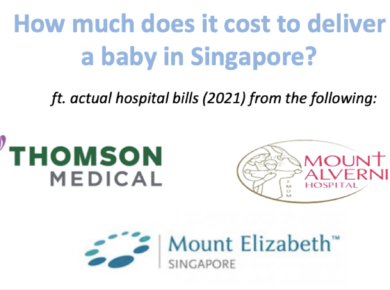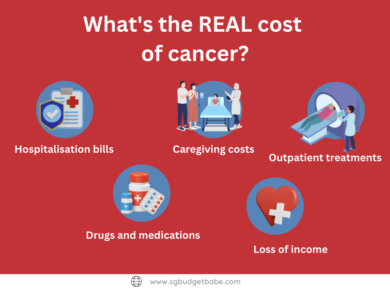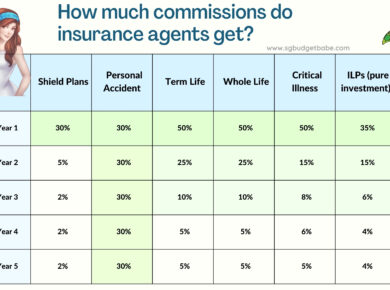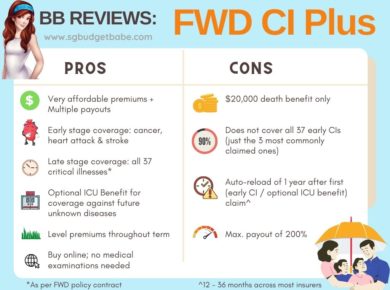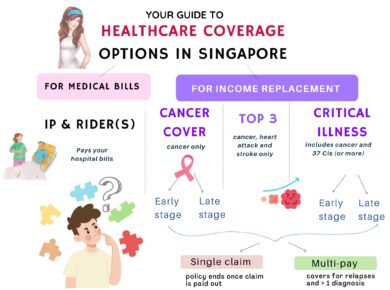The Ministry of Health (MOH) announced several new changes to MediShield Life earlier this year, in light of rising healthcare costs that they say necessitated higher premiums. As a result, some consumers are now having difficulty keeping up with the rise in their insurance premiums. The question on everyone’s mind is thus whether MediShield Life is sufficient, or if one still needs a private Integrated Shield plan (IP) to supplement it. In this article, I will address that issue, as well as whether your IP riders still make sense from here.
This is Part 2 of a series on hospitalisation coverage and medical insurance in Singapore. Click to view Part 1 here.

Healthcare costs have been rising. As a result, with larger claims being made against both MediShield Life and private insurers, consumers like you and I have been paying higher premiums for healthcare protection in the past few years.
Why, and how does this happen?
This is largely because insurance works via risk-pooling – here’s a helpful graphic by MOH to illustrate this concept:

Unfortunately, the rapid rise in costs over the last few years can be attributed to several factors at play – including medical inflation, higher operating costs, and even a “buffet syndrome” when it comes to the consumption of medical treatment and services (since it’ll be paid for by your insurer anyway).
This is not sustainable, and we’re already starting to feel the heat.
Why co-payments are the way to go
When consumers have to foot a portion of their hospitalisation bills (instead of leaving it entirely to your insurer), it should theoretically make one think twice about consuming healthcare services, or choose public hospitals instead of private ones whenever possible.
And indeed, MOH has now mandated that zero co-payment IPs are no longer allowed to be sold (after 2018).
This is definitely a step in the right direction. Aside from that, further changes to MediShield Life have been made. Great Eastern has put together the below table which covers the key changes:

Aside from these changes, you may want to pay close attention to the following:
- All consumers (even those with existing IP or IP supplementary plans) will now have to fork out a minimum 5% co-payment towards their hospitalisation bills.
- You’ll only be able to claim 25% of your private hospital bill from MediShield Life (down from 35%).
The second change is important, because this means private insurers will now have to foot a larger share of each private hospital bill (75% now vs. 65% previously). This could likely lead to higher claim costs for the insurers, and I won’t be surprised if this will be potentially passed to policyholders in the form of higher premiums.
Expect higher premiums (for both public and private hospitalisation insurance)
Unless we manage to curb the rising healthcare costs as a nation, it is only a matter of time that our insurance premiums will continue to rise. This isn’t just happening amongst the private insurers – even our mandatory insurance scheme hasn’t been spared.
As a result, another change announced by MOH earlier this year is that we’ll now have to pay more (up to 35%) for our MediShield Life premiums:

When you add up the premiums for your MediShield Life and private IP, it is likely that most of you guys are paying annual premiums anywhere between $1,000 – $2,000 easily right now (myself included). If you’re in the older age bands, or have more riders on your plan, you’re likely paying even more.
Obviously premiums cannot be allowed to continuously rise at an unsustainable rate, which is why some insurers like AIA, Prudential and Great Eastern have introduced Claims-Adjusted pricing.
How will Claims-Adjusted pricing affect me?
This framework will reward consumers who stay healthy and make no (or low) claims, since they will now benefit from lower insurance premiums. As a result, it should incentivise more people to take better care of their health, such as by eating healthier and integrating exercise into their weekly routines.
Conversely, if your health is poor and you end up making more claims on your insurance, then the trade-off will be that you’ll have to pay more (towards the risk-pooling) in the form of higher premiums the following year.
Here’s an example of how the changes might look like for Great Eastern policyholders with GREAT TotalCare (Elite-P) and (Classic-P) plans:


Thus, assuming you are at the Standard Level, you can expect to pay 20% lesser premiums next year if you don’t make any claims this year – if your plan is with Great Eastern.
In the event that your total claim size is more than $2,000 for treatment at a private hospital, you’ll be moved up to the next level (e.g. pay 50% more). But if you choose to seek treatment at government or restructured hospitals, then you’ll remain at the same level, which means you pay the same premium amount as your current / move up to Standard if you were previously at Preferred.
So, should I still keep my Integrated Shield plan?
In order to answer that question, you need to understand exactly how your IP helps you when it comes to reducing your cash outlay for hospitalisation bills:

You can see (in the second column) the difference an Integrated Shield plan can make to your bill in reducing how much cash you’ll have to pay out of your own pocket when you’re hospitalised. However, if your hospital bill is larger, the cash outlay you will need to pay can still be pretty sizeable.
Since we cannot predict in advance what health conditions may befall us, or what kind of treatments we’ll end up needing…this makes it difficult to save up some buffer cash for such situations. Consider the recent case of an unlucky 31-year-old hawker who got into a traffic accident on his way home from work, and racked up a $100,000 bill at Khoo Teck Puat Hospital (a public hospital).
So if that worries you and you want more assurance when it comes to your hospital bills, you can see that adding another layer of coverage with riders (third column)- such as via a supplementary plan like GREAT TotalCare (regardless of whether you opt for Elite-P or Classic-P) to partially cover the deductibles and co-insurance portion of your bill – can help cover up to 95% of your total hospital bill.
That way, you end up co-paying only 5% of your hospital bill i.e. essentially the minimum that MOH has mandated. This is a fairly popular approach that many people have opted for, with 1 in 3 of the population having IPs with a rider.

Of course, if you want to add on even more coverage, add-ons such as GREAT TotalCare Plus Rider or even Supreme MediCash can give you more benefits – but just note that you’d have to pay for the premiums in cash (and not from your MediSave).
For a complete hospitalisation coverage, you can add on Supreme MediCash to help provide daily hospital cash benefit to close up the co-payment gap. GREAT TotalCare Plus Rider, on the other hand, will give you 24/7 specialised support for overseas emergency situations.
The questions you’ll need to ask yourself are:
- Can I afford to pay for all that premiums?
- How much am I willing to pay for the benefits given by the additional rider(s)?
My personal take is that while it sounds attractive to add as many riders as your insurer offers you (such as GREAT TotalCare Plus Rider by Great Eastern), which can extend your coverage to include overseas medical bills…this is a benefit that some of us can do without if we intend to seek treatment only in Singapore. As such, it is highly likely that even if we pay to add on this rider, it’ll potentially be an option we might never end up utilising.
Which is why I feel opting for just the IP and a basic supplementary plan (or rider) might just be good enough for me.
Using Great Eastern’s GREAT SupremeHealth enhanced with GREAT TotalCare supplementary plan as an example, you will get covered for
- up to 95% coverage of your total hospitalisation bill,
- pre-hospitalisation coverage of 120 days,
- post-hospitalisation coverage for up to 365 days (one year) to focus on your recovery, and even
- long-term cancer treatment coverage.


According to Great Eastern, their GREAT TotalCare Classic-P has one of the most comprehensive list of benefits in the market at an affordable premium, making it one of the most value-for-money health plans.
Here’s another illustration showing how your MediShield Life + Integrated Shield plan + riders will stack up to give you a more complete coverage of your hospitalisation bills:

But while 5% co-payment sounds reasonable, what happens if my bill is $200,000? That 5% will then cost me at least $10,000, and I may not have that kind of liquid cash lying around!
Considering how 100 patients in Singapore hit the annual claims limit on their MediShield Life in 2019 and have no further coverage for their hospital bills (which were higher than $100,000), you may rightfully be concerned about not having enough cash to co-pay your hospital bill.
But there’s a solution for this. As long as you stick to the panel of specialists offered by your insurer and obtain pre-authorisation for any medical treatment and hospitalisation, you will not need to worry about having to pay anything more than the $3,000 co-payment cap.
Of course, if you prefer to choose your own doctor who’s not on your insurer’s panel, then you’ll have to be prepared to fork out potentially more.
Conclusion: Focus on what you can afford + pay attention to your health
As I grow older, I’ve begun to appreciate the wisdom of “health is wealth”. My metabolism has dropped, and my body no longer works as well as before. Gone are the days where I can indulge in junk food and not bother to exercise – today, I’m making more effort to eat healthier and schedule exercises like swimming or HIIT in my calendar.
But while I work on maintaining and improving my health, I still need insurance to cover me against rising hospital bills. This is why I continue to keep my IP and rider (supplementary plan), but choose not to pay for riders that entitle me to additional benefits such as overseas treatments because that will leave me with less money to pay for other types of healthcare insurance that I might also need (such as CareShield Life supplementary plans).
When you’re younger and still in the pink of health, it makes sense to get the highest hospitalisation coverage you need and can afford to pay for…before you risk becoming uninsurable.
But if you’re paying for more than what you can comfortably maintain, then you may want to check with your financial advisor whether it makes sense to either drop some rider(s), or downgrade your hospitalisation plan.
At the end of the day, we must focus on insurance that we can afford.
If you’re looking for Integrated Shield plans and/or riders that provide comprehensive coverage without costing an arm or a leg, while rewarding you for healthier living, you may want to check out Great Eastern’s plans here.
Sponsored Message:
For a limited-time only, you can sign up and enjoy 20% off your first-year premiums for GREAT TotalCare (Elite P) and (Classic-P) plans. Lifeproof your health today.
Find out more here or request for a call back.
Disclosure: This post is written in collaboration with Great Eastern. All opinions are that of my own, and information accurate as of 5 June 2021.
Notes:
1. GREAT TotalCare and GREAT TotalCare Plus are not MediSave-approved Integrated Shield plans and premiums are not payable using MediSave.
2. GREAT TotalCare is designed to complement the benefits offered under GREAT SupremeHealth. GREAT TotalCare Plus is a rider that can only be attached to GREAT TotalCare to extend medical coverage worldwide.
This advertisement has not been reviewed by the Monetary Authority of Singapore.
The above is for general information only. It is not a contract of insurance. The precise terms and conditions of this insurance plan are specified in the policy contract.
Protected up to specified limits by SDIC.


